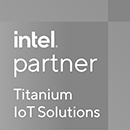NViS 5704: A Powerful 1U Rackmount NVR for Video Stream Analysis, Driven by 13th Gen Intel® Core-i Processor

In the present landscape, deep learning has become a standard feature in NVRs. Deploying model inference in NVR trained by CNN, RBFN, MLP, DBN and more is off-the-shelf function. Consequently, the task of selecting the appropriate, accurate, and real-time accelerator solution for gradual integration into the system has evolved into a crucial requirement within the surveillance market.
Challenge
Currently, a significant portion of the existing 1U Rackmount NVR market utilizes motherboards smaller than Micro ATX for incorporating supplementary PCIe cards. This choice is driven by the constraints posed by the inability to accommodate full-height and full-length cards. Moreover, the board's dimensions prevent the simultaneous inclusion of M.2 Key B and M.2 Key M interfaces. Complicating matters further, older Intel® platform CPUs can solely support PCIe x16 interface output. Consequently, enabling support for M.2 Key M PCIe 4.0 x4 necessitates a reduction in the specification of the PCIe slot to PCIe x8. This situation imposes limitations on the addition of a graphics card.
Solution
Thanks to the significant enhancements in Intel®'s 13th Gen design, there has been a marked improvement in the CPU PCIe pipeline. This advancement includes a combination of PCIe 5.0 x16 and PCIe 4.0 x4 interfaces. This innovation allows for the inclusion of a PCIe 5.0 x16 slot for adding accelerator cards, along with an additional NVMe support slot (Intel® 13th CPU PCIe pipeline is presented in Table I). This technological leap also enhances NVMe performance by enabling PCIe 4.0 x4 support (The performance test result between PCIe 3.0 x4 and PCIe 4.0 x4 are presented in Table II). With this upgrade, NViS5704 no longer utilizes standard Micro ATX form factor design, which now enables it to be equipped with a PCIe slot supporting both PCIe 5.0 x16 and M.2 Key M PCIe 4.0 x4 configurations. Consequently, users have a broader range of options to choose from, catering to their specific requirements.
TABLE I: 13th Gen Intel® Core™ CPU PCIE PIPELINE

TABLE II: BENCHMARK BY WINDOWS 10 + CRYSTAL DISK MARK 5.2.1
|
WD SN740 NVMe SSD
M.2 2280 Key M PCle Gen4 x4 |
PCIe 3.0 x4
|
PCIe 4.0 x4
|
||
|
WD SDDPNQD-256G
|
Read [MB/s]
|
Write [MB/s]
|
Read [MB/s]
|
Write [MB/s]
|
|
Seq Q32T1
|
3565
|
1980
|
4081
|
2026
|
|
4K Q32T1
|
350.2
|
176.2
|
887
|
1166
|
|
Seq
|
2756
|
1979
|
3613
|
2026
|
|
4K
|
70.17
|
148.8
|
87.44
|
317.6
|
With the inclusion of an additional PCIe 4.0 x4 interface, users have the capability to integrate accelerator cards like the Hailo-8 M.2 interface module. This facilitates the seamless adoption of various Hailo-8 modules, effectively boosting video streaming inference performance. Such require compatibility with higher specifications of the PCIe 4.0 x4 speed specification. On the other hand, if the PCIe pipeline specification fails to meet the requirements of accelerator cards, it could result in a significant reduction in inference performance. (Hailo-8 performance test result between PCIe 3.0 x4 and PCIe 4.0 x4 are presented in Table III).
TABLE III: HAILO-8 PERFORMANCE TEST RESULT BETWEEN PCIe 3.0 x4 AND PCIe 4.0 x4
*Benchmark by YOLOv5m and SSD_MobileNet_V1 of object detection

|
Hailo-8 with 13th Gen Intel® Core™ i9-13900E M.2 2280 Key M Gen4 PCle x4
|
PCIe 3.0 x4
|
PCIe 4.0 x4
|
|||
|
Object Detection
|
Input Resolution
|
FPS
|
Input Resolution
|
FPS
|
|
|
YOLOV5m
|
640 x 640
|
178
|
640 x 640
|
217
|
|
|
SSD_MobileNet_V1
|
300 x 300
|
862
|
300 x 300
|
1053
|
|
Conclusion
NEXCOM NViS 5704 NVR, powered by Intel® 13th Gen Core-i processor, presents a significant advancement in overall performance. The CPU incorporates thread director technology, enabling partial control of the OS scheduler. This innovation leads to more energy-efficient and power-saving software development, enhancing the execution arrangement of applications. Additionally, NEXCOM NViS 5704 NVR has been enhanced with an additional PCIe 4.0 x4 interface to support high-speed NVMe and accelerator cards. This enhancement propels 1U Rackmount NVRs to a higher level, expanding their scope beyond video recording and display functionalities. These capabilities empower security office to efficiently monitor and analyze video streams, identifying potential threats and recognizing objects or individuals of interest in real-time.

- Related Links:
- NViS 66162: Revolutionizing Workstation NVRs for Enhanced Video Processing and Analytics
- Workstation Standard NVR NViS 66162/NViS 6602 Manages Video Streams Flawlessly
- Browse Other News:
- AI Emerges as a Game-Changer in Disaster Management: From Reactive to Proactive
- Revolutionizing Health Monitoring: A Self-service Health Check Kiosk Success Story with NDiS B338
- All White Papers News


